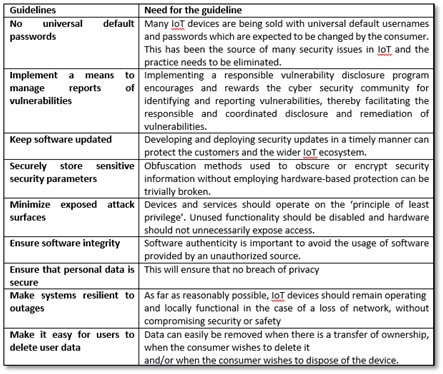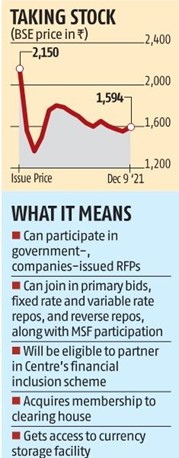Tuesday, 11th January 2022
CREA Report on progress of NCAP
In News
The Centre for Research on Energy and Clean Air (CREA), an independent research organisation, has reported shoddy implementation of the National Clean Air Programme (NCAP) by the states in its report ‘Tracing the Hazy Air: Progress Report on NCAP’.
About NCAP
- The Central Government launched National Clean Air Programme (NCAP) in January as a long-term, time-bound, national level strategy to tackle the air pollution problem across the country in a comprehensive manner with targets to achieve 20% to 30% reduction in Particulate Matter concentrations by 2024 keeping 2017 as the base year for the comparison of concentration.
- Based on the air quality data under National Air Quality Monitoring Programme (NAMP) and WHO data, the cities that violated the National Ambient Air Quality Standards (NAAQS) were put under the non-attainment cities list, covering 132 cities.
- The primary objectives of the plan as highlighted by the MoEF&CC are:
- To strictly implement the mitigation measures for abatement of air pollution
- To increase the air quality monitoring network in the country
- To enhance public awareness and capacity-building measures
Findings of the Report
CREA tracked the progress made by the states on implementation of NCAP indicators. Based on its findings, the report has made the following observations:
- Except city-specific action plans, no other plan has been formulated under NCAP prescribed timelines. The state action plans, regional action plans, and the transboundary action plan are yet to be formed.
- Only 15 cities of 9 states and union territories have completed the source apportionment study.
- None of the non-attainment cities has completed any kind of carrying capacity study while 31 cities have no mention of carrying capacity study being carried out.
- Carrying capacity is the region’s ability to accumulate and disperse emissions while maintaining breathable air quality.
- Emission standards for most of the highly polluting industries have not been revised.
- A web-based portal with a three-tier mechanism for monitoring, assessment, and inspection was to be developed by 2020. However, it has either not been developed or made publicly available.
- In three years, out of the targeted 1,500 manual monitoring stations that were supposed to be installed across the country, only 818 are present today and only 261 stations have the facilities with regard to monitoring PM2.5.
- Discrepancies and a lack of transparency vis-à-vis allocation and utilisation of funds to help reduce the emission of air pollutants were found.
Way Forward
- NCAP needs to be notified under the Environmental Protection Act, 1986 or the Air (Prevention and Control of Pollution) Act, 1981. This will make the programme legally binding to all the authorities.
- PRANA-NCAP portal by MoEF&CC should be populated with granular information updated at regular intervals on the performance of cities and authorities on indicators as highlighted in the NCAP report. The transparency for the financial support provided under NCAP should also be provided on the portal.
- NCAP should set interim mid-term targets that go beyond 2024 to achieve WHO's revised guideline levels over the next decade.
- The PRANA-NCAP portal should provide real-time monitoring of the city-wise progress on the indicators mentioned in the NCAP report to enhance accountability and transparency.
- Failure to abide by timelines for conducting various research studies (like Emission inventory and source apportionment studies, Carrying Capacity Studies and health baselines) should be penalised. These research studies are only helpful in setting a baseline if conducted within proper timelines.
- Distributing funds to non-attainment cities and its utilisation should be made entirely transparent.
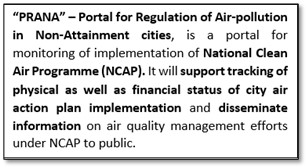
Sources:
China’s status as a ‘developing’ country at WTO
In News
China's status as a 'developing country' at the World Trade Organization has become a contentious issue.
About the News
- A number of nations have recently called on China to either refrain from seeking benefits available to developing countries or forego its classification as a developing country altogether at WTO.
- It has been highlighted that Upper middle-income nation including China are deriving benefits reserved for developing countries under WTO norms.
- Concerns have also been raised over the ‘least developed country’ (LDC) status, with Bangladesh potentially losing this tag after surpassing India in terms of GDP per capita.

What are the Concerns related to China’s Developing Status?
- As per a WTO, China is the second-largest economy in GDP terms, the first largest merchandise exporter, the fourth largest commercial services exporter and the first destination for inward FDI among developing countries.
- China’s per capita income was $10,435 in 2020 according to the World Bank while that of India was $1,928.
- So, the concerned countries have asked China to forgo the status as there has been a rise in China’s per capita income making it an upper middle-income country, as per the World Bank.
- China has also been blamed of alleged use of unfair trade practices such as preferential treatment for state enterprises, data restrictions and inadequate enforcement of intellectual property rights.
What can be the cascading effects of China giving away the Developing Status?
- If China is forced to take on the duties of a developed country and forego the benefits of a developing country, the West could soon ask other developing countries that are ahead of China (at least in per capita terms) to do the same.
- China’s fight to retain its developing country status is of interest not only to the Chinese people, but also to their counterparts including India especially in trade negotiations.
- So, China should take steps to categorically forego many benefits of being a developing country.
- It may also forego all exemptions available to developing countries in negotiations aimed at reducing skewed economic differences with other developing countries.
Sources:
Framework for operationalizing gold exchange: SEBI
In News
SEBI has recently come up with a framework for operationalising the gold exchange, wherein gold will be traded in the form of electronic gold receipts (EGRs).
About the News
- The new framework will come into force with immediate effect and under it, the stock markets can launch contracts with different denomination for trading or conversion of EGR into gold.
- Under the framework, the entire transaction has been divided into three tranches– (i) creation of EGR; (ii) trading of EGR on stock exchange and (iii) conversion of EGR into physical gold.
- A common interface will be developed by depositories, which will be made accessible to all the entities that include vault managers, depositories, stock exchanges and clearing corporations.
- This comes after the government declared "electronic gold receipts" as ’securities’ under the Securities Contracts (Regulation) Act 1956

The New Framework
- Gold considered for conversion: The existing deposit of gold lying in the vaults that has never been out of the vaulting infrastructure are considered for conversion into EGR.
- Eligibility criteria: This 'gold' must comply either with LBMA Good Delivery Standard or with the India Good Delivery Standard, or any other standard specified by SEBI.
- Lowered cost of withdrawal: "Interoperability between vault managers" has been allowed and EGRs have been made "fungible"(mutually interchangeable) to lower the costs of withdrawal of gold from the vaults.
- Increased Reach of Gold Exchange: All existing branches of vault managers which meets the safety standards, are allowed as 'collection and/or withdrawal center to increase the reach of Gold exchange.
- Withdrawal Charges: The storage and withdrawal charges will be levied by the vault managers and collected by the depository from the beneficial owner of EGRs.
- Quality check for Gold: Assaying agencies for checking the purity of gold will be empanelled if required at the time of withdrawal of gold from the vaults.
- Logistics support: Vault managers may provide a list of logistics service providers on their website with relevant contact details to enhance safe transportation of gold.
Understanding the 3 Tranches
- First Tranche: It relates to the creation of physical gold.
- Here the vault manager on receipt of physical gold will record the relevant information in the common interface and create the EGR.
- The vault manager has to ensure that no EGR is created without the presence of corresponding physical gold in its vaults.`
- The EGR will reflect in the demat account of the beneficial owner maintained with the depository participant and
- The depository will have to take necessary action to make EGR tradeable on the stock exchange.
- Second tranche: In this, the stock exchanges will allow trading of EGRs on continuous basis.
- The depositories will have to share information pertaining to the creation of EGR, with the exchanges and clearing corporations on a periodic basis.
- The clearing corporation will have to settle the trades executed on the stock exchange, via transferring EGR and cash to the buyer and seller of EGR, respectively.
- Third Tranche: It relates to conversion of EGR into physical gold.
- The beneficial owner of EGR intending to obtain physical gold will request the depository for the same which will be forwarded to the vault manager.
- The vault manager after delivering the gold to the beneficial owner will share the required data with the depository for reconciliation.
- The depository, sends this information about the extinguished EGR to the stock exchange and clearing corporation for necessary revision in the records.
- Any dispute relating to quality of physical gold, at the time of withdrawal the same would be dealt with by obtaining quality report from empanelled assayer.
Source:
Lal Bahadur Shastri
On January 11, 1966 Lal Bahadur Shastri, the second prime minister of India breathed his last. He died reportedly because of a cardiac arrest. But, the cause of his death is disputed. One of the greatest leaders in the history of India, Shastri is remembered as a man of the people. Shastri was born on October 2, 1904 in Uttar Pradesh’s Mughalsarai town. The former prime minister was inspired by a teacher at his school to participate in the freedom struggle. Just three months before his Class 10 exam in 1921, Shastri attended a meeting in Varanasi, where Mahatma Gandhi urged students to join the non-cooperation movement. Shastri dropped out of school and joined the Congress Party as a volunteer and participated in anti-government protests. Shastri was arrested but released from jail soon as he was a minor. He is credited with promoting the White Revolution (a national campaign to boost milk production) as well as the Green Revolution, which helped boost the production of foodgrains. Shastri gave the slogan “Jai Jawan Jai Kisan”. Hail the Soldier, Hail the Farmer. Shastri led India during its war with Pakistan in 1965. The war came to end with the Tashkent Agreement on January 10, 1966.
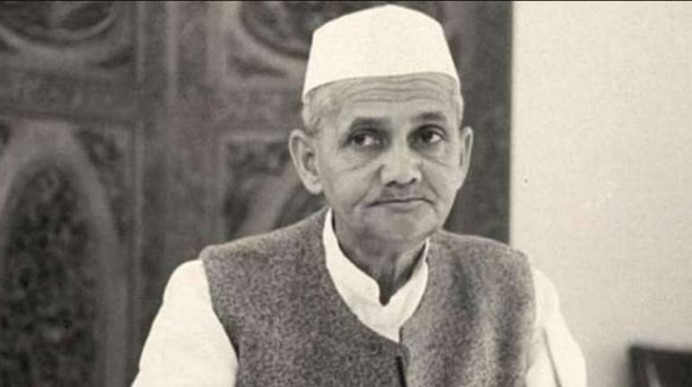
Source:
Media and issues of Responsible Reporting
In News
The Chief Justice of India expressed his concerns over ideological stances and biases in news reporting.
Introduction
- Free and unbiased media is supposed to be the most vital of the four ‘pillars’ of democracy - the executive, legislature, judiciary, and the free press.
- Media has an immense responsibility of speaking truth to power and holding up a mirror to society. However, it is becoming extremely difficult to fulfill.
- The media, like the judiciary, is supposed to stay neutral and report anything happening on ground zero with absolute neutrality, and no political or ideological bias.
- However, there are grave challenges to uphold this as seen during the COVID reporting and often seen during elections.

Evolving Trends in Media and News Reporting
- Demand for Specialized Journalists: Earlier, one reporter could be deputed to report on diverse subjects. However, the nuances of reporting contemporary news in specific fields require specialization. E.g., media houses have specialized Legal Editors, Sports editors etc.
- IT Revolution and Rise of Digital Media: Apart from the traditional print media, we also have digital news media platforms and social media reporting. The better aspect of this transformation is that there is now more information available to people which is easily accessible. But, these transformations have also resulted in worrying trends.
- Nowadays, everything is subject to reporting 24x7. In the race for ratings, the important journalistic tenet of verification before publishing is not being followed. This leads to incorrect reporting.
- The social media amplifies that incorrect news in a matter of seconds. Once published it is difficult to take back.
- Unlike print and electronic media, it is almost impossible to hold the social media platforms such as YouTube, Twitter etc. accountable for derogatory and defamatory stuff which has potential to ruin careers and lives.
- The seeping of ideological stances and biases into the news story: Interpretation and opinions are coloring what should be factual reports. News mixed with views is a dangerous cocktail.
- Problem of partial reporting: This is connected to bias reporting and involves cherry-picking facts to give it a particular color. For instance, select portions of a speech get highlighted – mostly out of context - to suit a certain agenda.
- The Attention Economy: To grab the eyeballs, the headlines for news reports are catchy, but misleading. The headline is often unreflective of the actual content of the reports. It is interpretative and imaginary. The headlines are then shared widely on social media, and become the news. The content is forgotten.
- Fake News: This is a huge problem these days. The mainstream media has been found reporting based on social media forwards without verifying the facts. This was evident during the farmers protest and also in COVID reporting.
- Growing commercialization of Media: The corporate giants controlling mainstream media houses have also engaged in severe competition among themselves dishing out news and content which is primarily dominated by sensationalization, sleaze and glitz to capture wider markets.
- Investigative Journalism: It is a good evolution in a sense that it provides valuable information regarding corrupt practices which may go unnoticed. However, in this era of sensationalization and commercialization, this has also fallen prey to the vested interests. Journalists do sting operations to defame their competitors or promote some political power without any regard to public interests.
Biased Reporting versus Democracy
- Media bias in itself causes democratic backsliding and increases authoritarian practices because the media is neither holding the government accountable nor informing the public about policies that strengthen the incumbent’s power.
- In addition, government efforts to constrain the media harm journalists, undemocratically violating citizens’ rights and physical safety. Freedom House’s ‘Freedom in the World Report 2021‘ rates India as only two on a four-point scale for a “free and independent media”.
- A biased media also prevents citizens from receiving information that might be essential to public wellbeing by filtering information through a lens that supports vested interests first.
- Media bias plays an influencing role at the voting booth as propaganda can skew voter decisions and perceptions of what is true. Political parties capitalize on this bias to influence public attitudes and further their own power.
From Media Bias to Media Neutrality
- Although it’s difficult to convince larger outlets to participate since they benefit from their government and business advertisements, smaller independent outlets can start a movement towards neutrality.
- Public Subscription based model of news reporting may be one good way to free the media of advertisement based revenue. This will help media and journalists to remain independent and focus on unbiased and responsible reporting.
- The Press Council of India (PCI) has updated and revised the Norms of Journalistic Conduct, 2020. Media Houses and reporters must adhere to it.
- It addresses the Five Core Principles of Journalism - Truth and Accuracy; Independence; Fairness and Impartiality, Humanity and Accountability.
- It also lays down the provisions regarding Investigative Journalism, its Norms and Parameters.
- Government has notified Information Technology (Intermediary Guidelines and Digital Media Ethics Code) Rules 2021. Digital media platforms must abide by these rules and violators must be penalized strictly.
- The Standing Committee on Communications and Information Technology presented its report on ‘Ethical Standards in Media Coverage’. It recommends the following -
- Restructure the PCI, and establish a statutory media council to cover all types of media (print, electronic and digital).
- Check the manipulation of TRP system by creating a more transparent system for measuring TRPs
- Include grievance redressal mechanisms at all levels (i.e., district, state, and centre) as at present, there is no grievance redressal mechanism for an individual to register a complaint for redressal of his grievance, if something is written against him/her.
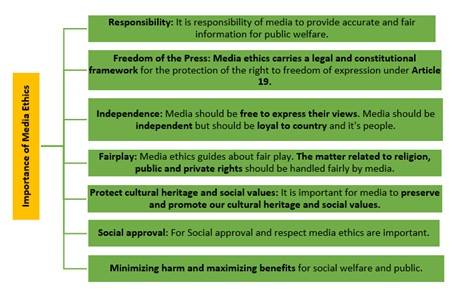
Conclusion
The freedom of the press is a sacrosanct Constitutional right. From the very beginning, the Supreme Court of India has upheld the freedom of the press as an important facet of our Constitution, from Sakal Papers and R. Rajagopal to Anuradha Bhasin. However, this freedom comes with an enormous responsibility that must be borne by every individual who is part of the journalistic enterprise, the journalists, editors, and management. As Justice Frankfurter, the judge of US Supreme Court once said- “The freedom of the press is not an end in itself but a means to the end of achieving a free society.”
Question: “The freedom of the press is not an end in itself but a means to the end of achieving a free society.” Critically discuss in context of Indian Democracy
Sources:
Gateway to Hell
This is image of the Gateway to Hell, a fiery crater that has been burning in the Karakum Desert, Turkmenistan, since 1971. Recently, Turkmenistan President has ordered experts to find a way to this natural gas crater, the Darvaza gas crater also known as the ‘Gateway to Hell’. Calling it a human-made crater, the President said it “negatively affects both the environment and the health of the people living nearby. The crater is 69 metres wide and 30 metres deep. While the details of the origin of the crater are contested but it has been said that the crater was created in 1971 during a Soviet drilling operation. As reported by the BBC, in 1971, Soviet geologists were drilling for oil in the Karakum desert when they hit a pocket of natural gas by mistake, which caused the earth to collapse and ended up forming three huge sinkholes. This pocket of natural gas contained methane, hence to stop that methane from leaking into the atmosphere, the scientists lit it with fire, assuming the gas present in the pit would burn out within a few weeks. In 2018, the country’s president officially renamed it as the “Shining of Karakum”. Scientists have been able to find bacteria living amidst the burning crater, which is not found in any of the surrounding soil outside of the crater.
Sources:
New Bridge over Mahakali River
- Context: The Union Cabinet has approved the MoU between India and Nepal to build a bridge over the Mahakali River at Dharchula in Uttarakhand.
- Mahakali River also known as Kali or Sharda River, originates at Kalapani in the Himalayas at an elevation of 3,600 m (11,800 ft) in the Pithoragarh district in Uttarakhand.
- It flows along Nepal's western border with India and has a basin area of 5,742 sq m.
- It joins Ghaghara River (tributary of the Ganges) in southwest of Bahraich (UP).
- The water of this river is also used for hydro-electric power generation.
- The construction of the bridge over the river will not only help people living in Uttarakhand and Nepal but will also enhance the unique ties of friendship and cooperation that both countries share as close neighbours via open border and deep-rooted people-to-people contacts of kinship and culture.
- India and Nepal have been working together on different regional forums such as SAARC, BIMSTEC
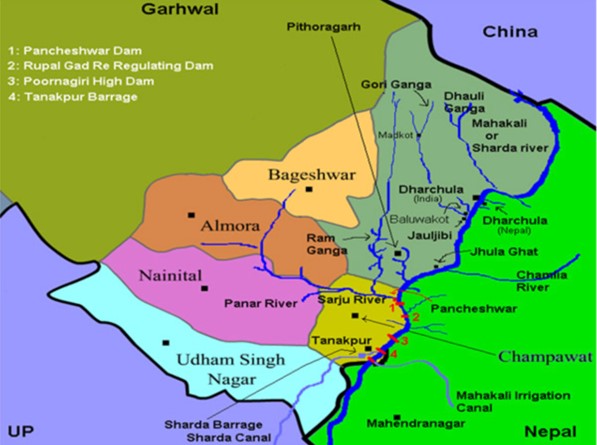
Source:
India to emerge as world’s 3rd largest economy in 2031
- Context: According to a recent report, India is likely to overtake Japan as Asia’s second-largest economy by 2030 and world’s No.3 by 2031.
- Currently, India is the sixth-largest economy, behind the U.S., China, Japan, Germany and the U.K.
- Key observations
- India’s nominal GDP is estimated to rise from $2.7 trillion in 2021 to $8.4 trillion by 2030. This will result in the size of Indian GDP exceeding Japanese GDP by 2030, making India the second-largest economy in the Asia-Pacific region.
- India’s consumption expenditure will double from $1.5 trillion in 2020 to $3 trillion by 2030. The key factor for this is India’s large and fast-growing middle class that helps to drive consumer spending.
- India’s real GDP growth rate is projected to be 8.2% in 2021-22, rebounding from the severe contraction of 7.3% in 2020-21.
- The economy will continue to grow strongly in 2022-23 at a pace of 6.7%.

Source:
Statehood demand for Puducherry
- Context: Chief Minister of Puducherry has recently demanded Statehood for the Union Territory of Puducherry.
- Union Territories (UTs) are the federal entities which are administered by the Union Government of India. In UTs, Lieutenant Governors are appointed by the President of India who serve as their administrators.
- There are two types of Union Territories in India:
- UTs with Legislature: Delhi, Jammu and Kashmir, and Puducherry
- UTs without Legislature: Chandigarh, Andaman and Nicobar, Dadra and Nagar Haveli and Daman and Diu, Ladakh, and Lakshadweep (unicameral legislature).
- Being a land of frequent dispute between the French and Dutch in the late 17th century, Puducherry remained a French colonial possession until it was transferred to India in 1962.
- It was formed of the four former colonies of French India namely Puducherry, Yanam, Karaikal and Mahe.
- The demand for Statehood has been persistent in Puducherry because, apart from political advantages such as not depending on Centre’s appointed LG for decisions, there are tangible advantages that the people can enjoy if the UT becomes a state such as: becoming a member of the Finance commission, having its own High Court, public service commission, education boards, own reservation rules, increased investments etc.
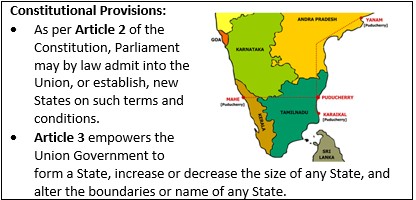
Source:
Mekedatu Project
- Context: The Centre has stated that Karnataka would not carry out any construction on the Mekedatu dam project until its Detailed Project Report (DPR) is approved.
- Mekedatu, is a deep gorge situated at the confluence of the river Cauvery and its tributary Arkavathi.
- The project aims to store and supply water for drinking purposes to Bangalore and 400 megawatts (MW) of power generation is also proposed via the project.
- The project’s proposed reservoir site, Ontigondlu is said to be in the midst of the Cauvery Wildlife Sanctuary.
- There is a huge risk of 5,051 hectares of forests being submerged with the implementation of the project.
- River Cauvery rises on Brahmagiri Hill of the Western Ghats in south-western Karnataka. Its tributaries include: Hemavati, Lakshmantirtha, Kabini, Amaravati, Noyil, and Bhavani rivers.
- The Cauvery River passes through the Cauvery Wildlife Sanctuary, which is a protected area located in the Mandya, Chamarajanagar and Ramanagar districts of Karnataka.

Source:
Preparing companies for climate change: HBL
Essence: The article talks about the problem of climate change and its inevitable impact on businesses. Climate change can impact the businesses in several ways like making the products, services obsolete or change the market that the company serves. Large corporations though having resources to identify the risk and opportunities would still need help of specialized agencies, so is the case of Small Corporation who lacks resources. Businesses would need to judge their vendors or services on climate parameters.
In this respect, the article talk about the recently introduced International Sustainability Standards Board (ISSB), which focuses on a set of standards that will look at the full environmental, social and governance (ESG) space. There are two ways to consider the impact of climate change (CC) on a company: the impact that the climate will have on it and the impact that the company will have on the climate (and the environment). Given the pacing impacts of climate change, business considering a significant investment in vulnerable cities like Mumbai need to start planning their responses now.
Why do we need to read this article?
- To understand the various heads under which the impact of climate change on the business can be assessed.
- To understand how businesses can impact climate change.
- To understand why there is a need of specialized agency to identify the risks and opportunities related to climate change.
Source:
The sail that Indian diplomacy, statecraft need: TH
Essence: Invitation to the five leaders Central Asian Region to the Republic Day Parade, is a clear indication that this region is going to be of prime importance in India’s continental security. Having said that, the article highlights various geopolitical challenges too.
India has tried to correct its neglect of maritime security and respond to the military rise of China by steps like SAGAR but they are still not sufficient to counter China’s increasing intervention beyond maritime domain focussing on continental Eurasia. Apart from this, India has serious border and connectivity issues especially in the Eurasian continent in terms of connectivity. Geopolitics suggests that even US may not have a very substantial hold in the Indo- Pacific region in times to come.
The article suggests that India needs to have more assertive push for continental rights and strike a good balance between maritime and continental security.
Why to read this article?
- To understand why is it important for India to strike the right balance between continental and maritime security especially in the Eurasian region.
- The article becomes relevant not only because it discusses India’s new approach towards the Central Asian Region, but also highlights the rise of China, the current position of US and other smaller but essential geo-political issues of Eurasian continent (GS II, International Relations).
Source:
Understanding the Eurasian Turmoil: IE
Essence: The editorial discusses the prominence of Europe and Russia over multiple security issues in Eurasian Region that includes Belarus, Kazakhstan, Afghanistan, etc. Russia has the upper hand in most of these issues- Russia is at the geographic centre of most of the crisis, weak economic globalization of East European countries, formation of regional institutions like Eurasian Economic Union and Central Security Treaty Organization. Countries like Poland and Hungary are into “democratic backsliding” and are refusing to accept Brussel’s supremacy. Issues relate to rule of law, migration, refugees, energy, etc.
On the other hand, one could witness how Russia is being opposed while being loved. Its regional organizations aren’t as effective as EU’s. Growing dominance of Islamic fundamentalism is threatening the orthodox Christianity of Russia. Countries like Kazakhstan have proposed “multi-vector diplomacy”, thus devaluing Russian dominance.
EU and China are 2 new rival powers in the region and in comparison to Russia, they are larger in economy and commerce. Yet, it is Russia controlling the geopolitics with the nations in turmoil in Eurasian region. The editorial concludes by saying that opposing stakeholders will have to loosen their grip, develop a cooperative agenda on security, de-escalate military tension, etc. to lead the way for peaceful international relations in Eurasian region.
Why you should read this article?
- To understand the diverse nature of crisis that countries in Eurasian region are facing.
- To analyze the role of EU, Russia, China, USA, etc. in resolving the Eurasian crisis.
Source:
Devotion to the work is Devotion to God
Background
- Agro-tourism can be successful in places with agricultural heritage, and India has a high potential in this sector.
- Agritourism is a concept made popular in India by Pandurang Taware. The farmers associated with his venture say it has given a boost to their regular income.

About the Work of Pandurang Taware
- Pandurang, who is known as the ‘Father of Agritourism’ Concept in India, has helped 600 Farmers Earn over Rs.58 Crore.
- Pandurang was 32 years old when he decided to move from a well-paying job to agritourism.
- Agritourism, as a concept, has been prevalent in Europe for a long time and has many takers as well. Pandurang saw potential in establishing a similar concept in India as well since 2002.
- By learning the do’s and don’ts in agritourism, Agri Tourism Development Corporation (ATDC) was launched from Maharashtra by Pandurang.
- The idea behind the venture was not just to host urban dwellers but to make sure that they experienced the life of a farmer. Along with this, the fresh produce from the farm is also available for purchase and this also boosts the income of the farmers.
- ‘Sevarth madhe parmarth’ — meaning do something that will benefit not just you but those around you — with this philosophy in mind, Pandurang has managed to make life immensely comfortable and successful for himself and more than 600 other farmers in Maharashtra.
- The team managed to make over Rs 50 crores pre-COVID via sales of farm produce and the tours they’ve conducted. The farmers associated with this venture have got a boost to their regular income.
Quote: “The ultimate goal of farming is not the growing of crops, but the cultivation and perfection of human beings.”
― Masanobu Fukuoka
Source:
Share the article
Get Latest Updates on Offers, Event dates, and free Mentorship sessions.

Get in touch with our Expert Academic Counsellors 👋
FAQs
UPSC Daily Current Affairs focuses on learning current events on a daily basis. An aspirant needs to study regular and updated information about current events, news, and relevant topics that are important for UPSC aspirants. It covers national and international affairs, government policies, socio-economic issues, science and technology advancements, and more.
UPSC Daily Current Affairs provides aspirants with a concise and comprehensive overview of the latest happenings and developments across various fields. It helps aspirants stay updated with current affairs and provides them with valuable insights and analysis, which are essential for answering questions in the UPSC examinations. It enhances their knowledge, analytical skills, and ability to connect current affairs with the UPSC syllabus.
UPSC Daily Current Affairs covers a wide range of topics, including politics, economics, science and technology, environment, social issues, governance, international relations, and more. It offers news summaries, in-depth analyses, editorials, opinion pieces, and relevant study materials. It also provides practice questions and quizzes to help aspirants test their understanding of current affairs.
Edukemy's UPSC Daily Current Affairs can be accessed through:
- UPSC Daily Current Affairs can be accessed through Current Affairs tab at the top of the Main Page of Edukemy.
- Edukemy Mobile app: The Daily Current Affairs can also be access through Edukemy Mobile App.
- Social media: Follow Edukemy’s official social media accounts or pages that provide UPSC Daily Current Affairs updates, including Facebook, Twitter, or Telegram channels.


